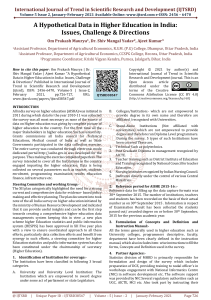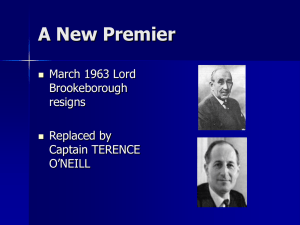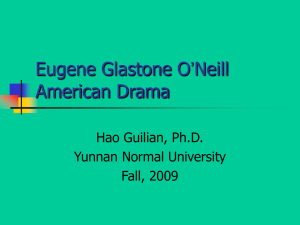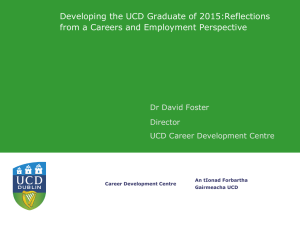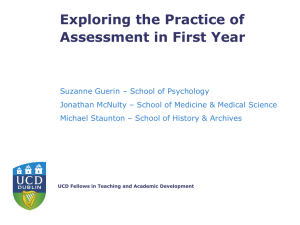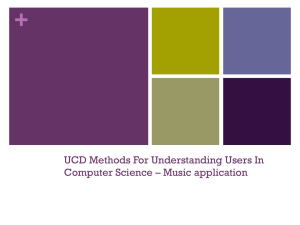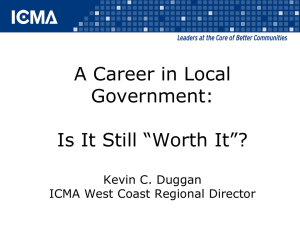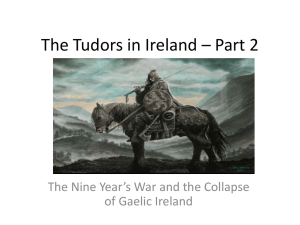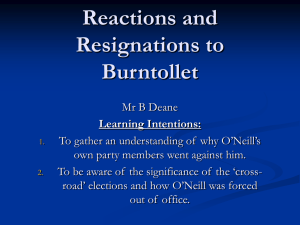Empowering Students - University College Dublin
advertisement
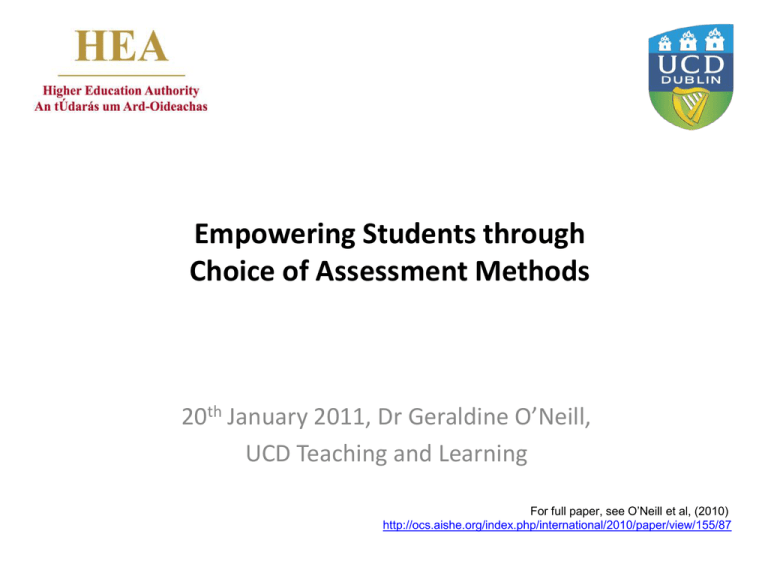
Empowering Students through Choice of Assessment Methods 20th January 2011, Dr Geraldine O’Neill, UCD Teaching and Learning For full paper, see O’Neill et al, (2010) http://ocs.aishe.org/index.php/international/2010/paper/view/155/87 Driver 1 Student-centred • Empowering students to take some responsibility in how and what they learn is a studentcentred approach (O’Neill & McMahon, 2005). Choice of Assessment • By extending this decisionmaking to students having a ‘choice of assessment methods’ allows them to take some control of their learning. Good assessment practice (Craddick & Mathias, 2009; Fowell et al, 1999) Driver 2 Inclusive Assessment • This is also supports an ‘inclusive assessment approach’ (UCD project: HEA funded (Rose & Meyer, 2000; Healey et al., 2008). Literature Choice of assessment methods within a module Both assessment choices should have coherent alignment with learning, outcomes, assessment criteria, marking procedures, .. (Craddock & Students perform better according to first choice (Jackson & Williams, 2003; Cassidy, 2007) Mathias, 2009) Students very positive towards empowerment, with older students more receptive (Francis, 2008) ‘Staff should take steps to empower their (1st Year) students by creating a student-centred curriculum through which students can take control of, and responsibility for, their own learning’. (The Quality Assurance Agency for Higher Education, 2008) (see also UCD Education Strategy) However, Parity of effort (support, etc) must be built into assessment design and communicated to students. (Easterbrook et al, 2005) Methodology: Design Process Template for two purposes: a) Staff equity consideration and b) information for giving student an informed choice. Sections • • • • • • • • • • • Choice of diverse assessment (two choices) Weighting to module Details Why it might suit students Learning outcomes to be assessed Assessment criteria Marking procedures T& L activities Feedback mechanisms Workload Examples of assessments, if unfamiliar Methodology : Student presentation • Student were all given a • face to face introduction, in week one, to their choice of assessments. • The motivation behind it was explained, i.e. to allow • them to play their strengths, take some control over their learning. • They were all given the ‘Student Information & Equity Template’ (also put on Blackboard™) to help make informed choice. Assessment Examples were put on ‘Blackboard ™’ where available. Students were also given a set date (weeks 2-4) to inform staff of choice. Last year’s Modules (2009/2010 only): The Case Studies Modules Student Level/ Numbers Weight. of choice Method Choices (Choose A or B) Group v Individual Choices Timing Choices: More continuous versus end of semester choice A. Group poster (N= 1 group) Group only Both same time Module 1. Development & Advanced Pharmacology Level : 3 UG Students: n=60 20% Module 2: Ecological and Environmental Microbiology Level : 3 UG Students: n=56 50% Module 3. Human Rights Law and Equality Level : 4 (Masters) PG Students: n=33 100% B. Group oral (N= 10 groups) A. Problem-solving Individual only assignments (N=42 students) B. Seen exam N=14 students) A. Group Group (with the project/individual individual (N=28 students) aspect) assignment versus Individual B. Essay (N=5 students) More continuous versus end of semester More continuous versus end of semester This year’s Modules Modules Module 4. Computer Science: Data Mining (Tahar Kechadi) Module 5: The Making of Early Modern France (Jean-Michel Picard) Level/ No Level 4 n=50 Level 1 n=20 Weight. of choice Method Choices (Choose A or B) 20% A. Homework Tutorials B. Project work 100% A. Group Presentation B: Group poster A. Essay Module 6: Medicine Research Elective (Amanda McCann) Level 3 n=20 50% Group v Individual Choices Timing Choices: Individual only Both Continuous Group only Both same time Individual only Both same time B; Audio-visual assignment A: Poster B. : oral presentation Both same time Individual only To be designed Module 7. Forensic Radiography: Medicine and Medical Science (Jonathan McNulty) A. Essay Level 4 n=20 50% Individual only B. On-line wiki contributions More continuous versus end of semester Evaluation Methods: • Staff Interviews (module co-ordinators) • Student Questionnaire including a 20 statement scale that measures the ‘Positive Experience of Assessment Methods Choice’ (PEAMC): ‘Positive Experience of Assessment Methods Choice’ Scale (PEAMC). This included subscales that addressed: • level of anxiety in choosing assessment; • equity between assessment methods; • the diversity of choice; • sense of empowerment in choosing; • and support given during the process. Results/Demographics Full sample student population was n= 149. 97 students returned the questionnaire, a response rate of 65%. 27 were male (27%) and 67 were female (68%). 17 identified themselves as mature students, i.e. over 23 years of age (17%). The majority of student (82%) were glad with their choice and those students not satisfied (9%) with their choice noted that the workload on the assessment should be slightly reduced for that assessment. Implication, choosing well is important Mature Students Stronger Preference Empowerment Theme: Median of Questionnaire Statements (N= 3 module, 97 students) I appreciated being given a choice of Strongly Agree assessment methods I felt I had should have had more control of Disagree my assessment in this module Anxiety Theme: Median of Questionnaire Statements (N= 3 module, 97 students) Having a choice of assessment reduced some Agree of the stress I normally experience with assessment Disagree I found it stressful to have to chose an assessment method Diversity Theme: Median of Questionnaire Statements Having a choice of assessment method allowed me to Agree play to my strengths I would like to have had a wider variety of choices of Undecided assessment methods in this module -’I struggle with calculations sometimes, so thought the essay would give me a better chance to show other strengths’ (S6) ‘Special Accommodation’ (SA) • one student did not require ‘SA’, as assessment used a more visual than verbal format. (staff observ.) • Another student, who requires ‘SA’ for an examination format, chose the continuous assessment option and reduced need for SA ………….. this student remarked on the benefits of not having to have this organised especially for her (staff observ.) More ‘Hidden’ Accommodations Home-life arrangements (student quote). Social Class (staff observ.) Organisational skills (student quote). Demands of parallel modules (student quote). ‘I could work from home’ (Galway!!)’ (student quote). Accommodated Competing Diversities Personally, I prefer end of semester exams.(S35) I don't do well under exam circumstances.(S15) Challenged staff pre-conceptions about ‘what is academic work’. • ‘I (lecturer) am now considering, that is it possible that you can talk about theory..It doesn’t have to be in the written format, all the time. We have (in the past) exclusively assessed by written work’. (staff quote) Assessment Option B Equity Assessment Option A Equity Theme: Median of Questionnaire Statements The assessment method I chose was not explained as well Disagree as the other assessment method Over the course of the semester, the workload (and level Agree of feedback ) for my choice appeared similar to the other assessment method(s) Undecided I was satisfied with the examples available of my assessment method compared to the examples of the other assessment method Equity of Grades Options A (Less traditional) Group poster Options B (Traditional) Group oral ProblemSeen exam solving Group Essay project/individ ual Median Grade Median Grade B B+ Overall grades were higher, than previous year. However, some student groups (who were good performers in class, engaged and articulate, but often ‘underachieve’) did better than usual. Summary of Students Experience Very Positive However, students suggested: Two choices was enough ‘I feel that giving choice of assessment methods has allowed me to show my strengths in research and understanding concepts, ……’ And some better examples Staff Recommendations for Practice • A) Careful planning of the choices and then B) articulating these choices clearly to the students. They advocated the use of the ‘Student Information Template’ for both. • Choice of assessment in this project was introduced early, then students had to sign off on this. Some of the staff suggested a ‘cooling off period’ to allow students to change options. • The staff recommended that consideration be given to having quite diverse assessments, to maximise on student diversity. • Whereas, all staff advocated the choice of assessment within a module, it also should be considered at programme level. Programme Approach: advantages & disadvantages Module Approach: advantages & disadvantages In conclusion: • Allows students choose, from a • Allows students experience a Develop empowerment ‘carefully’ setby choice of assessment range of planned ‘alternative designing choice at bothmethods, module (some) assessments’ systematically over and programme approach. • Could be extended to allow the period of a programme students negotiate their own (Knight, 2000) choice (negotiated assessment, • Efficient use of resources learning contracts..) • Can be mapped to Graduate • More student controlled, Attributes (O’Neill, 2009; • However, essential Treleaven & Voola, 2008) skills/competencies need to be • However, staff, and not student, monitored, i.e. writing skills controlled. cannot be completely avoided. For further details on this project/research, contact the project co-ordinator: Dr Geraldine O’Neill 00 353 1-7162839, geraldine.m.oneill@ucd. See also http://www.ucd.ie/teaching/projects/ch oiceofassessmentmethods/ Acknowledgment HEA Training of Trainers Funding for supporting this project. References: Ashworth, M., Bloxham, S., & Pearce, L. (2010). Examining the tension between academic standards and inclusion for disabled students: the impact on marking of individual academics' frameworks for assessment, Studies in Higher Education, 35: 2, 209-22 Cassidy, S. (2007). Assessing ‘inexperienced’ students’ ability to self assess: Exploring links with learning style and academic personal control, Assessment & Evaluation in Higher Education 32: 313–30. Craddock, D., & Mathias, H. (2009). Assessment options in higher education, Assessment & Evaluation in Higher Education, 34:2,127- 140. Entwistle, N.J., & Tait, H. (1990). Approaches to learning, evaluations of teaching and preferences for contrasting academic environments. Higher Education 19: 169–94. Francis, R. A.(2008). An investigation into the receptivity of undergraduate students to assessment empowerment, Assessment & Evaluation in Higher Education, 33:5,547—557 Fowell, S. L., Southgate, L. J. & Bligh, J. G. (1999). Evaluating assessment: the missing link? Medical Education 33:4, 276-281. Easterbrook, D., Parker, M., & Waterfield, J., (2005) Engineering Subject Centre Mini Project: Assessment Choice Case Study. HEA-Engineering Subject Centre. http://www.engsc.ac.uk/downloads/pdfs/Resource/assessmentchoice.pdf accessed 8th July 2010. Garside, J., Nhemachena, J, Z., Williams, J., & Topping, A. (2009) Repositioning assessment: Giving students the ‘choice’ of assessment methods. Nurse Education in Practice. 9, 141-148. Healey, M., Roberts, H., Fuller, M., Georgeson, J., Hurst, A., Kelly., K., Riddell, S., Weedon, E. (2008). Reasonable adjustments and disabled students experience of learning, teaching and assessment. Interchange, Spring 2008, http://www.tla.ed.ac.uk/interchange/spring2008/healey2.pdf accessed 7th July 2010. Hanafin, J, Shevlin, M. , Kenny, M, McNeela E. (2007). Including young people with disabilities: Assessment challenges in higher education, Higher Education, 54, 435-448. Jackson, R.H.G., & Williams, M.R.. (2003). Are undergraduate preferences as to method of assessment well-founded and rational? Research paper 2003-1 Cardiff: University of Wales. http://66.102.1.104/scholar?hl=en&lr=&q=cache:P81sN9lSAlAJ:www.aber.ac.uk/smba/english _ver/research/rsp2003/rp20031.pdf+Jackson+and+Williams+Are+undergraduate+preferences+as+to+method+of+assessment +well+founded+and+ rationale+2003 accessed 25th June, 2007. Knight, P.T. (2000) The Value of a Programme-wide approach to Assessment. Assessment & Evaluation, 25 (3), 237-251 Lowe, K. & Marshall, L. (2004). Plotting renewal: Pushing curriculum boundaries using a web based graduate attribute mapping tool. In R. Atkinson, C. McBeath, D. Jonas-Dwyer & R. Phillips (Eds), Beyond the comfort zone: Proceedings of the 21st ASCILITE Conference (pp. 548-557). Perth, 58 December. http://www.ascilite.org.au/conferences/perth04/procs/lowe-k.html Nightingale, P., Te Wiata, I., Toohey, S., Ryan, G., Hughes, C., & Magin, D. (1996) Assessing learning in Universities. Sydney: University of New South Wales Press. O’Neill, G., & McMahon, T. (2005). Student-Centred Learning: What does it mean for students and lecturers? In, Emerging Issues in the Practice of University Learning and Teaching pp. 27-36. Dublin: AISHE publication. O’Neill, G. (2010). UCD Inclusive Assessment Project. http://www.ucd.ie/teaching/projects/choiceofassessmentmethods/ accessed 12th July 2010. O’Neill, G. (2009) A programme-wide approach to assessment: a reflection on some curriculum mapping tools. Paper presented at AISHE, Dublin. http://ocs.aishe.org/aishe/index.php/international/2009/schedConf/presentations O’Neill, G., Doyle, E., O’Boyle, K., Clipson, N. (2010) Choice of Assessment Methods within a Module: Students’ Experiences and Staff Recommendations for Practice. Dublin: AISHE Conference Presentation/Paper publication, 26th/27th August, 2010, http://ocs.aishe.org/index.php/international/2010/paper/view/155/87 Quality Assurance Agency for Higher Education (2008), p4 http://www.enhancementthemes.ac.uk/documents/firstyear/Personalisation%20%20Final.pdf Quality Assurance Agency (QAA) (2003). Learning from subject review 1993–2001: Sharing good practice. Glouchester: Quality Assurance Agency for Higher Education. Treleaven, L. & Voola, R. (2008) Integrating the Development of Graduate Attributes Through Constructive Alignment. Journal of Marketing Education, 30; 160 Rose, D. & Meyer, A. (2000). Universal Design for Learning Journal of Special Education Technology 15: 1, Winter 2002 Waterfield, J. & West, B. (2006). Alternative and inclusive assessment case studies - a staff development resource, In Inclusive Assessment in Higher Education: A Resource for Change University of Plymouth. Plymouth, SPACE Project http://www.plymouth.ac.uk/pages/view.asp?page=10494 Accessed July 2010 . Waterfield, J., West, R. & Parker, M. (2006) Developing an Assessment Toolkit in Inclusive Learning in Higher Education, In (Eds.) Adams, M. and Brown, S. Towards Inclusive Learning in Higher Education: Developing Curricula for Disabled Students Routledge: London Wiggins, G. & McTighe, J. (2005). Understanding by Design. Second Edition. Alexandria, Virginia: Association for Supervision and Curriculum Development.
